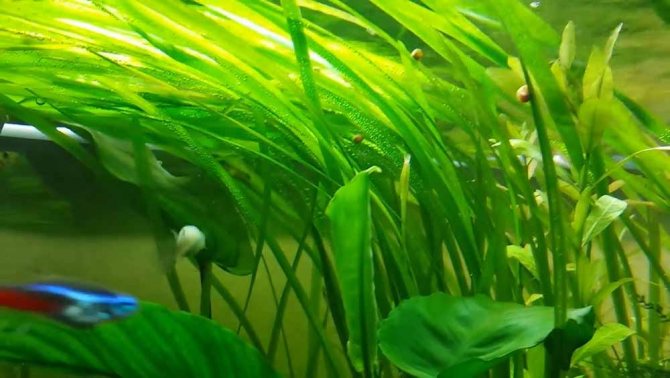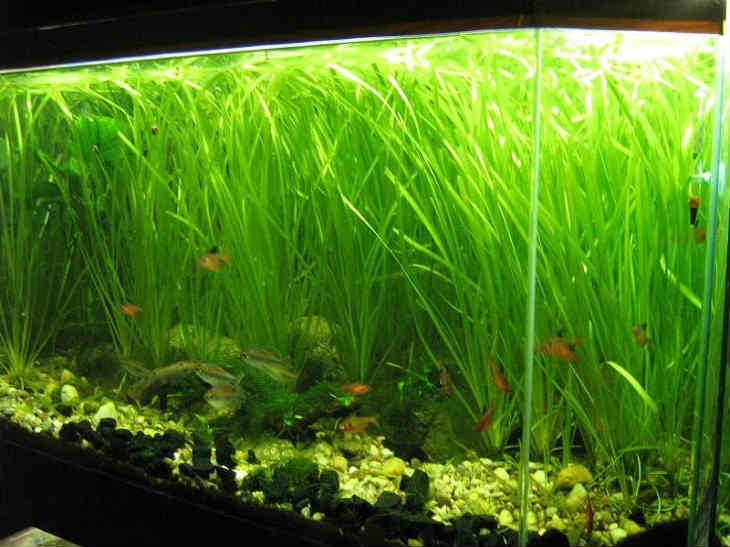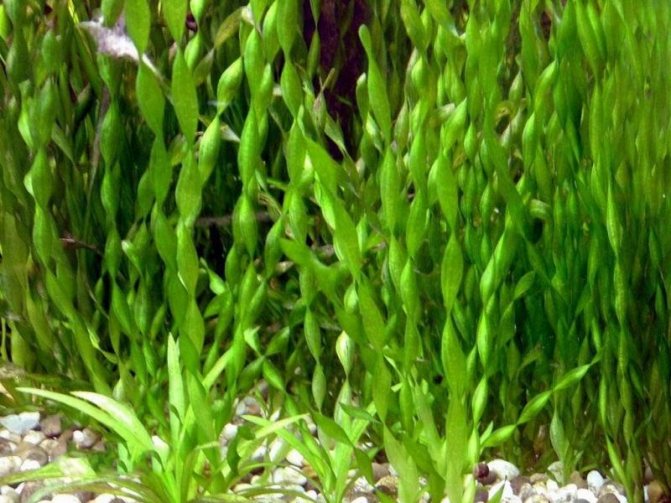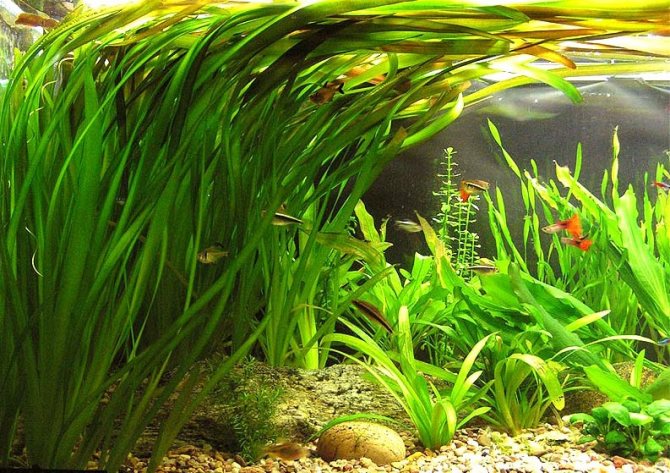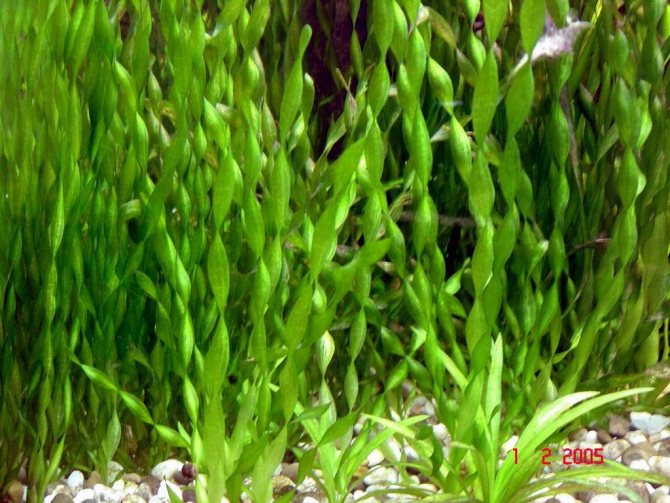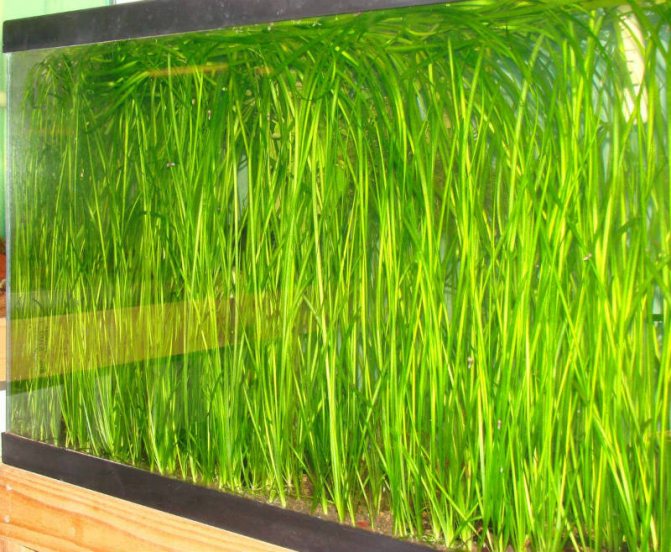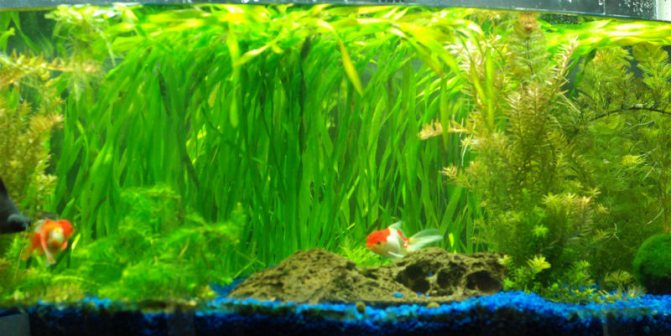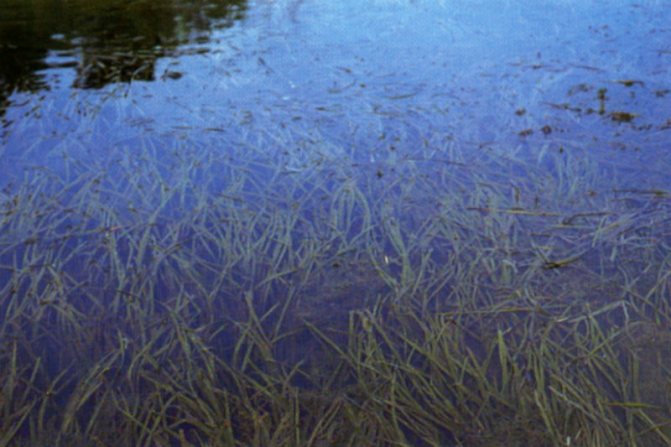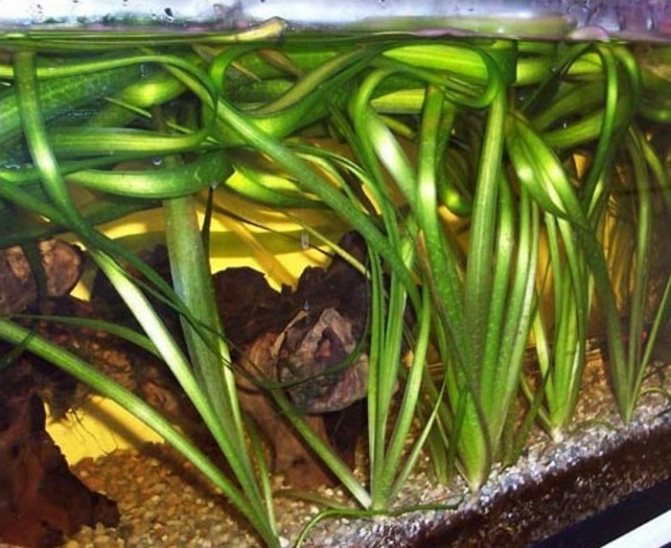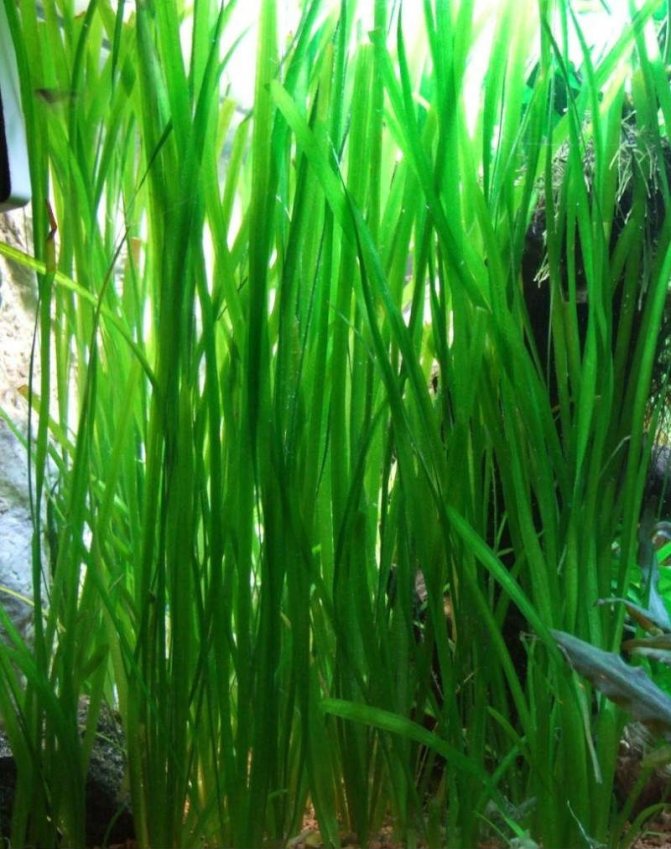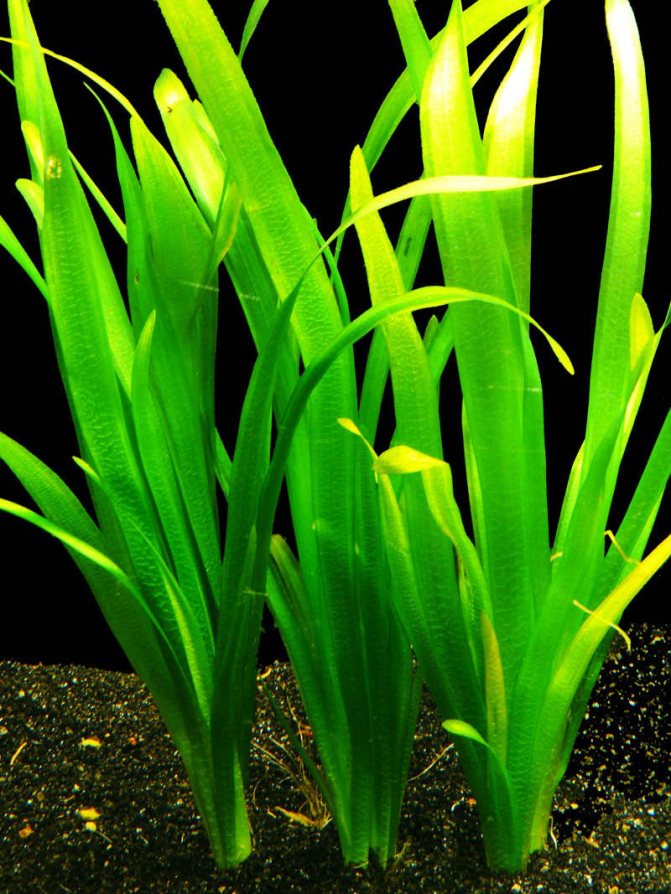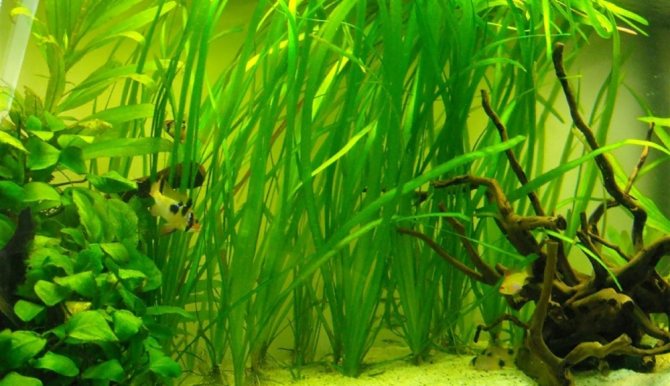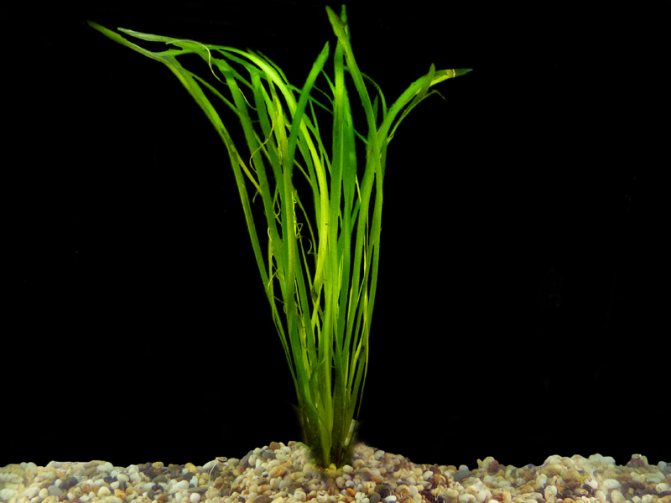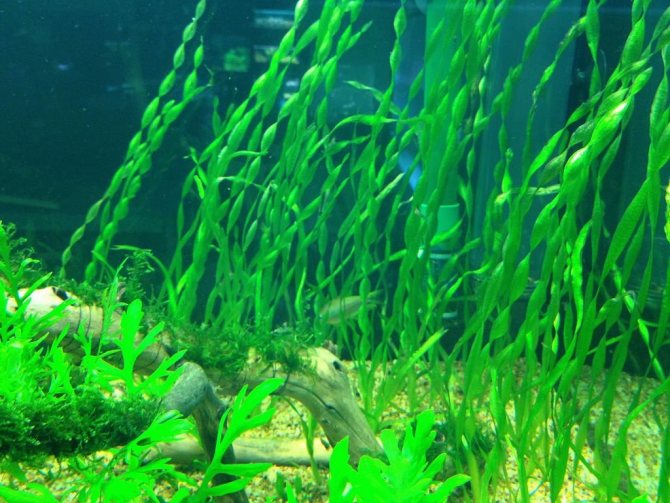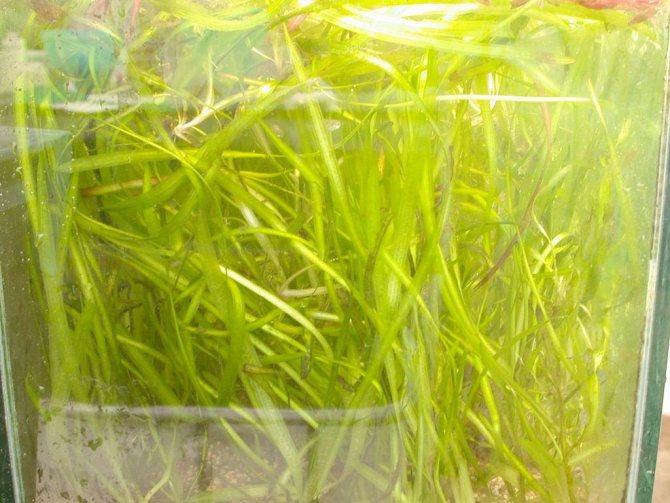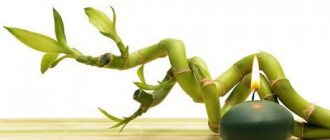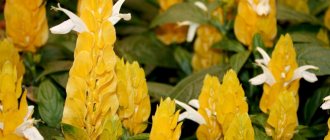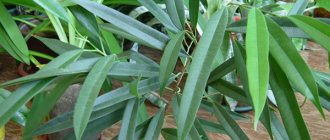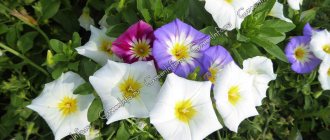Vallisneria is an aquatic plant that belongs to the Vodokrass family.
Vallisneria spiral is one of the species of this rather numerous family.
Due to its unpretentiousness at the present time, this species can be found in all fresh, stagnant and flowing water bodies that are located in the tropical and subtropical zone.
Vallisneria spiral is a perennial aquarium plant, quite tall (in aquariums it can reach 50 cm, it grows even more in nature). In small and low aquariums, its leaves will cover the entire surface, creating a thick shade.
As a rule, it is with this plant that beginners in aquaristics begin their acquaintance with the world of aquatic vegetation.
When purchasing spiral wallisneria for your aquarium, be prepared for the fact that after a while, under good conditions, it can fill all the free space. Therefore, it is better to plant it at the far or side wall, in the corners. To maintain the reservoir in a decent form, the plant should be thinned from time to time by pruning and removing the daughter plants. In no case, do not cut off the tops of the leaves of Vallisneria, from such treatment it quickly dies.
This plant has a well-developed root system, but at the same time it is quite delicate, so it is advisable to give preference to fine pebbles, gravel or coarse sand from soils. However, if necessary, Vallisneria is quite capable of adapting to any other types of soil.
It is undemanding to lighting, you can use both bright and dim light, artificial or natural. It does not need additional lighting (unless it is in the farthest and darkest corner of the room). But, it is likely that other inhabitants of the aquarium will need it, since due to the long and thick leaves there will be constant shade in it.
As for the water parameters, there are some nuances here. Vallisneria spiral is accustomed to warm water, therefore the minimum temperature is 20 ° C. Colder water greatly slows down the growth of the plant. The highest comfort temperature is 27 ° C. The acidity is the same as for most aquarium fish - 5-7 pH. But with rigidity, everything is not so simple. Vallisneria vulgaris can adapt to hardness up to 15 ° dH, while for the spiral, its upper limit is 8 ° dH, otherwise the leaves of the plant greatly decrease in growth, and its development slows down.
In addition, absolutely all types of Vallisneria do not tolerate excessive salinity of water (its presence can be only in very small quantities) and absolutely do not tolerate the presence of rust (they quickly die).
As for water changes, Vallisneria is unpretentious in this respect. It can easily grow in water that has not changed for a long time, but this can have a detrimental effect on other inhabitants of the aquarium.
General information
Algae can grow in stagnant water as well as in fast flowing rivers. They have vertical, ribbon-like sheet plates, the tops of which creep over the surface of the water. The foliage is highly decorative, so the culture is grown in aquariums and artificial reservoirs.
Due to the variety of colors and shapes, with the help of vallisneria, you can create an unusual aquarium, as well as saturate the water with oxygen and purify it, making it useful for aquatic life.
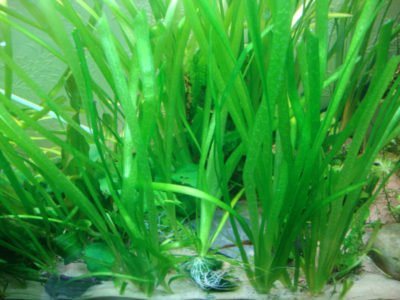
Vallisneria nana or narrow-leaved (Vallisneria nana)
Vallisneria nana (Vallisneria nana) has recently appeared in the aquarium hobby, originally from Northern Australia. In its natural habitat it reaches a height of 15 cm, hence its name "nana" or dwarf. In aquariums, Vallisneria nana can grow up to 70 cm in height if not trimmed regularly.
Vallisneria nana leaves are light green, long, narrow ribbons (up to 1 cm), much narrower than other varieties of Vallisneria. Once planted, the aquarium plant will release many runners, resulting in a chain of plants that can create dense “curtains” in the aquarium that completely cover the back of the aquarium. Propagated by shoots.
Unlike other types of vallisneria, vallisneria nana is somewhat more demanding on the intensity of illumination. Lighting should be from 0.4 W / liter of water and above. If the lighting is weaker, or the bushes grow too densely, the plant will greatly slow down growth.
Vallisneria nana is a rosette plant that forms an impressive root system and needs a nutritious substrate or substrate with nutrients.
In too coarse soil, or in "bare" empty gravel, the plant may not take root at all.
To improve plant growth, it is recommended to regularly apply liquid fertilizers with an iron content (0.01-0.5 mg / liter) and CO2 (10-40 mg / liter) is also recommended.
Vallisneria nana can withstand a fairly wide temperature range, in the region of 15 - 30 ° C, but the optimum temperature for keeping is 24 - 29 ° C. This aquarium plant can exist in both soft acidic water and hard alkaline water. The carbonate hardness of the water should be between 2 and 21 ° dKH, pH 6-8.
If all the requirements for the content of vallisneria nan are met, then the plant does not require additional care and it is not difficult to maintain it.
Types and varieties of vallisneria
Vallisneria Spiral - This variety of Vallisneria was one of the first to be discovered and got its name due to the ability of its peduncles to twist in the form of a spiral. The culture is a rosette consisting of linear-type leaf plates, reaching a length of up to 80 centimeters. The edges of the leaf plates are finely serrated. Inflorescences are small. Before flowering, the peduncle floats to the surface, where pollination takes place, after which it again goes under water. The flowering time of the culture falls in mid-summer.
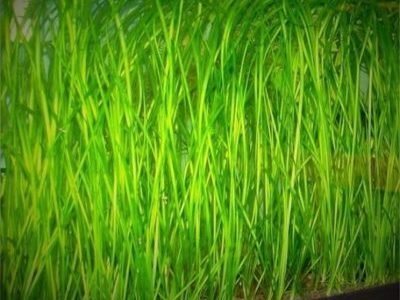

Vallisneria American - the plant consists of a shock of small, ribbon-like, long and soft leaf plates of light green color with a reddish tint. The height of the culture can reach up to 100 centimeters. It rarely blooms at home; in the wild, the plant blooms in mid-summer.
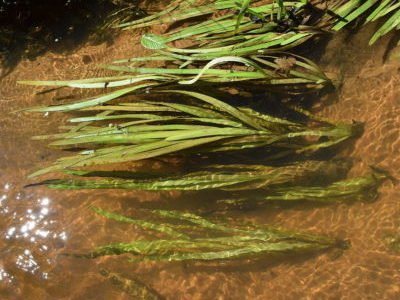

Vallisneria Giant - the height of the sheet plates can reach up to 2 meters, and the width up to 4 centimeters. Leaves are dark green, growing in bunches with serrated edges. This algae can be used for large and tall aquariums and artificial reservoirs.


Vallisneria Natans - is an aquatic plant, reaching a length of up to 100 centimeters. It can be grown in aquariums and artificial reservoirs. The culture has an underdeveloped, creeping root system and narrow, light green leaf plates with serrated edges. When grown in an aquarium, it does not bloom; it blooms in a pond in the middle of summer.
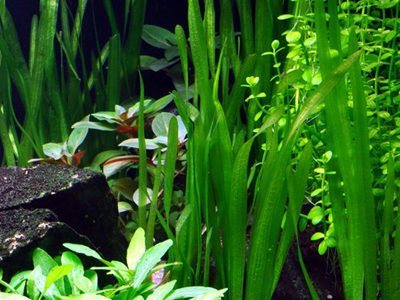

Vallisneria Tigrovaya
This type of culture can reach a length of up to 1 meter. The leaf plates are light green with small transverse stripes and black dots.Due to its decorative variegated colors, the plant got its name “tiger vallisneria”.
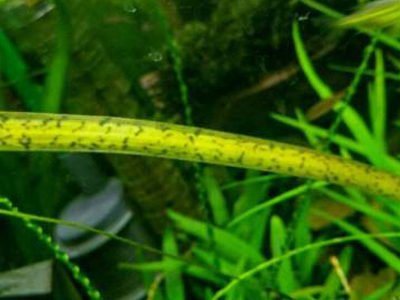

Vallisneria Twisted-leaved - in the wild, this plant species grows in Vietnam, Central Asia and Japan. The culture has dark green leaf plates, which are about 40 centimeters long. They are spiral-shaped and have jagged edges. Vallisneria's vegetation lasts throughout the year. When grown in an aquarium, it rarely blooms, does not give seeds.


Vallisneria Asian - the culture reaches 50 centimeters in length, and the diameter of the algae is up to 10 centimeters. It has fragile, spiral-shaped leaf plates of bright green color and a powerful root system. The plant needs good lighting for normal development.
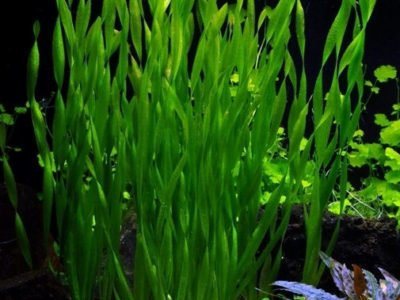

Vallisneria Ordinary Is the most common aquarium culture. It has long, bright green ribbon-like leaf plates, twisted in a spiral. The culture reaches a height of up to 80 centimeters. The plant has several varieties, differing from each other in height, shade of leaves and the degree of their curl. The root system is strong, thin and long, milky yellow.
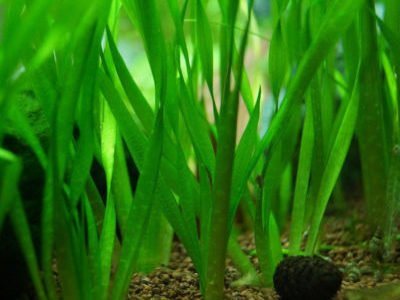

Vallisneria Leopard
It has long, straight, bright green leaves, reaching a height of 70 centimeters. While the leaf mass is young, it has a green tint, but as soon as the plant is a little over a year old, brownish streaks appear on the leaves, reminiscent of leopard spotting. In aquarium conditions, the culture does not bloom and does not bear fruit.
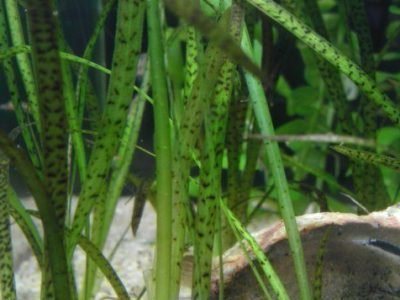

Vallisneria dwarf - is a dwarf variety with thin dark green leaf plates up to 50 centimeters long. The measles system is thin, flexible, durable. The plant is very fond of light, so it should be planted in the center of the aquarium so that other algae do not shade it.
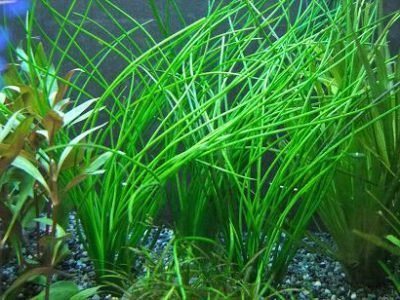

Vallisneria Floating - the plant reaches a height of 70 centimeters and has narrow, ribbon-like leaf plates of a bright green hue. The alga has no stem, the leaves grow from the roots. Reproduction occurs by side shoots.
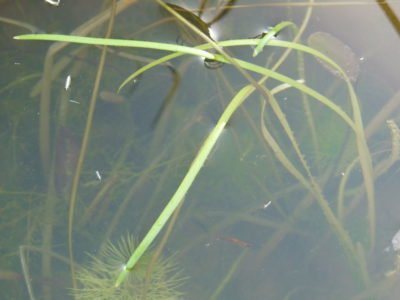

Vallisneriya Krasnaya - the culture has a compact, creeping root system and linear leaf plates with finely serrated edges, reaching a height of up to 1 meter. The color of the leaf plates depends on the intensity of the light and can be either green or light green near the roots and reddish-brown at the ends. When domesticated, the plant does not bloom.


Vallisneria asian
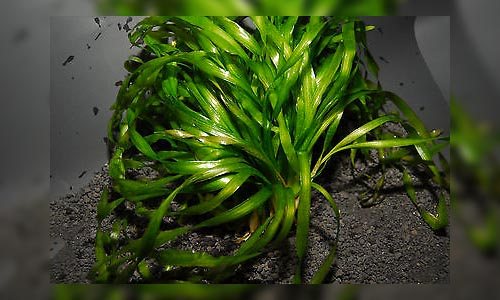

Vallisneria Asiatic is native to the subtropics of Asia, found in Lake Biwa (Japan). The plant was first described in 1934. The dark green leaves of this Vallisneria have a ribbon-like shape, reminiscent of a corkscrew. The height of the bush in aquarium conditions reaches 50 centimeters, in good lighting the bush reaches a diameter of about 10 cm.The plant is placed in the background or along the side walls of the aquarium.
Planted in bunches containing 2-3 bushes. In comfortable conditions, Asiatic Vallisneria grows rapidly and may require periodic thinning. It is worth remembering one feature of Asiatic Vallisneria: its leaves are very fragile and do not tolerate excessive bending. If the leaf is broken, it begins to die off gradually. The rest of the plant does not have any special requirements for its content, we recommend it to novice aquarists. Comfortable parameters: water temperature 22-28 ° С, hardness dH 6-10 °, acidity pH 5.5-7. Filtration required. Vallisneria asiatica does not like the excessive content of iron oxides and salts. Preferring cool water, the plant adapts relatively easily to higher temperatures, making it ideal for both cold water and tropical aquariums.
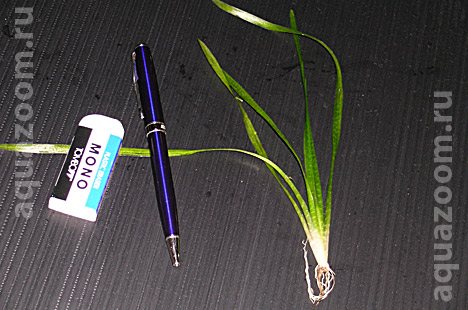

Lighting should be relatively bright, with an intensity of at least 0.8 W / liter.Daylight hours are 10-14 hours. Please note that in warmer water it is necessary to lower the light level so that the leaves in the roots are more durable. The soil can be sandy, consisting of a mixture of sand and fine gravel, or completely of fine gravel, but rich in nutrients. You can put pieces of clay under the roots. Vallisneria asiatica positively reacts to the addition of liquid micronutrient fertilizers to the water. Over time, the plant begins to die off old leaves, becoming at first spotty, then turn yellow and begin to decompose. It is worth carefully getting rid of such leaves by cutting them off at the base. Such pruning is harmless to the plant; soon a young shoot appears in the place of the old leaf. Asiatic Vallisneria reproduces vegetatively. The mother bush under the ground produces shoots at the ends of which a daughter bush is formed. As soon as 3-4 leaves appear on the daughter bush, it can be separated from the mother bush by cutting the shoot connecting it to the adult bush and replanting it to a new place in the aquarium. The Latin name is Vallisneria asiatica, a synonym for Vallisneria corkscrew.
Growing vallisneria in an aquarium
Vallisneria does not need much maintenance, which is why many new aquarists choose it.
In order for a plant to grow and develop normally, it must create a certain microclimate. Vallisneria is a light-loving crop that requires bright lighting. If there is little light, the plant will begin to weaken and slow down its growth, and besides, it will lose its decorative bright green shade of leaf plates.
Since algae are native to the tropics, it is very important for it to provide similar living conditions. The temperature indicators of the water in the aquarium should be at least 24 degrees and not higher than 32. If this value drops to 15 degrees, the plant will die.
Water in the culture aquarium should be filled only with medium hardness with a slightly alkaline or neutral medium. Tap water is not suitable, as it contains rust and salt impurities, from which the plant will suffer greatly. For this reason, the water must be filtered before pouring into the aquarium.
Since vallisneria is a tall plant, experienced aquarists advise planting it in the corner of the aquarium or along the back wall. Landing is quite simple. It is enough to spread the root system of the plant and bury it in the ground.
However, it often happens that the planted algae begins to float. To prevent this from happening, it is necessary to spread pebbles around the bush, leaving them for a week. Thus, the algae will be able to take root well and stop floating to the surface.
It should be noted that the culture does not need deep planting. If the aquarist buries the light part of the plant, which is located too deep at the bottom of the leaf plates, then Vallisneria will begin to die. The first sign of such a problem will be falling sheet plates.
It is best to plant the crop next to the filter, in the place where the water drains. This is necessary in order for the flow to distribute the algae evenly over the surface. It is also often used as a restraint for free-floating small plants that are placed in the water on top of its leaves. To fix the position of the algae afloat, you can use other aquarium cultures or small snags.


Vallisneria spiral
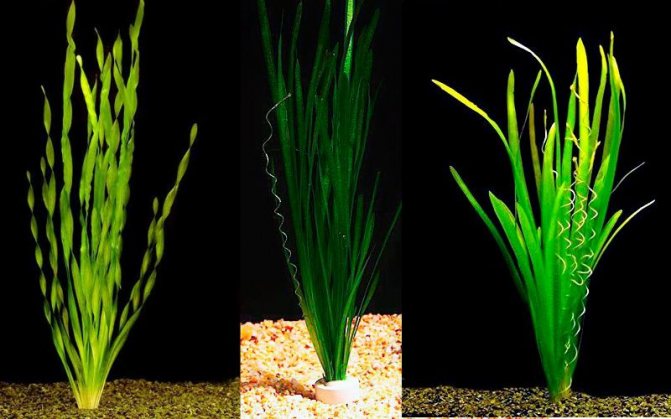

Vallisneria spiral photo
Appearance: spiral-shaped leaves, twisted in a corkscrew, up to 5 cm wide and about 50 cm long. Root system: delicate, white. Priming: should consist of small fractions (up to 2-3 mm). At the planting site, a layer with a thickness of at least 4 cm. Lighting: medium or bright - 40-70 lm / l. Water parameters: Comfortable temperature: 22 - 25 ° C.
pH: neutral or slightly acidic - 6.5 - 7.0.
Hardness dH: not higher than 8 °.
Placement in the aquarium: looks good in the center or background of an aquarium. Reproduction: vegetative, layering.
Vallisneria spiral is a popular aquarium plant. The plant received the name Vallisneria in honor of the Italian botanist Antonio Vallisneria. The plant got the name "spiral" not for the twisted leaves (in many plants of this genus, the leaves can curl depending on the conditions of keeping), but for the spiral into which the peduncle of a female flower coils after pollination.
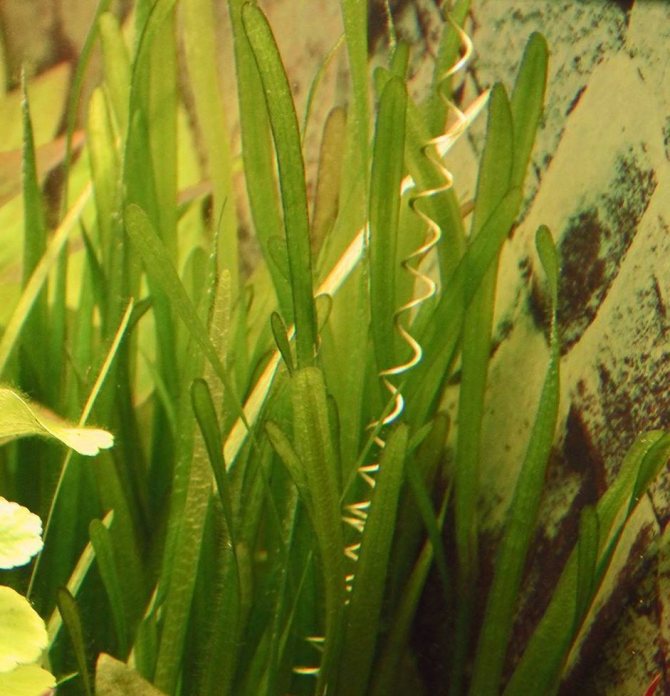

Vallisneria spiral photo
We can say that Vallisneria is spiral international - it lives in water bodies of Southern Europe, North Africa, the Middle East to America, Australia, Central Europe. Even on the territory of Russia, it is found in the reservoirs of Central Asia.
Vallisneria is a spiral water rosette plant rooting in the ground, having a structure like all representatives of this genus. Petiole long ribbon-like leaves, 50-80 cm long (up to 100 cm) and 8-12 mm wide with five veins, bright green, corkscrew-like twisted and form a linear rosette. The plant is firmly rooted in the ground with thin roots.
The plant is interesting and original, is very popular among novice aquarists, forms dense beautiful thickets. Therefore, it is most advisable to place it at the back of the aquarium. It is noted that Vallisneria release a large amount of oxygen into the water and absorb many dissolved elements that appear during the decomposition of organic matter in the reservoir. The water in an aquarium with many Vallisnerias will always be clean and transparent, you get a kind of living filter. Vallisneria spiral blooms in its natural habitat in the middle of summer, in an aquarium it is very rare, since amateurs, as a rule, have female specimens and seed reproduction under these conditions does not happen.
The flowers of Vallisneria are small, white, dioecious, i.e. male and female. Male flowers are located at the base of the leaves, female flowers float on a very long peduncle on the surface of the water. When the stamens ripen, the male flowers break off, float to the surface and fertilize the female flowers. After this, the peduncle of the female flower, twisting in a spiral, is shortened, and the seeds develop already under water.
Vallisneria spiral keeping in the aquarium
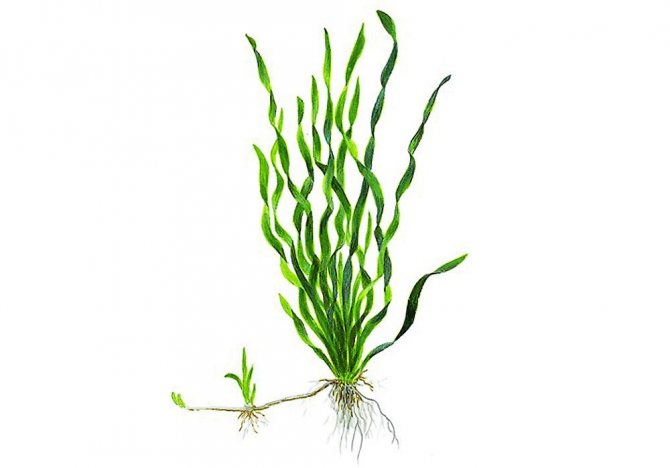

Vallisneria spiral photo
Any aquarium is suitable for keeping Vallisneria spiral. The recommended water temperature is 22-25 ° C, although the plant can grow at 15-20 ° C (but growth will slow down). Recommended hardness dH is up to 15 °, however, at dH of more than 8 °, the plant does not feel satisfactory (growth worsens and leaf size decreases). Active reaction of water pH 6.0-7.5 ° (neutral or slightly acidic). The change of water does not significantly affect the growth of the plant. The nature of the lighting is moderate or bright.
The Vallisneria spiral at times has enough natural light. Various lamp options can be used as sources of artificial light. The duration of daylight hours varies widely (8-12 hours).
The nature of the soil, its thickness and degree of nutritional value does not matter. The plant does not particularly need additional feeding. Tetra Plantamine will suffice if your plant is not doing well.
In an aquarium, Vallisneria reproduces vegetatively all year round with the help of many shoots, on which daughter plants appear in turn. One copy per year gives up to hundreds of new plants. You can separate the bushes after the formation of 3-4 leaves.
Vallisneria spiral video review
PRACTICAL NOTE ABOUT GROWING AQUARIUM PLANTS


This post can be found in all FanCheck articles about aquarium plants. This is a cheat sheet with a link that will help you grow any aquarium plant and herbalist of any complexity.
Most of the reference materials are located in the site section Aquascape, we also recommend our brochure: Aquarium Navigator for Beginners: "Semiramis Underwater Gardens".
The success formula for growing plants can be displayed as follows.
First of all, you need a proper level of lighting.
(light intensity - Lumens)
Further, the proper concentration of CO2
Further macro-fertilizers and micro-fertilizers
Water parameters, care and quality water changes
The gradation of this formula is built according to the degree of importance. The intensity of illumination is primary, and then downward. Therefore, if your plants have holes in the leaves, they have sciatica (twisted) or have problems with algae, then please do not read the "bad advice" - this is chlorosis (iron deficiency), this is a lack of potassium ... diarrhea, phimosis and endometriosis )
You always have to tackle the problem of attuning the herbalist from major to minor. Plants will die most quickly from a lack of lighting than from a lack of Fe and K. Moreover, the latter are always present to one degree or another in the aquarium, but it is difficult to measure their clear value.
Below, let's go from major to minor.
Lighting in an aquarium with plants... Remember, the most important thing in the world is this is its intensity (Lumens)! All other lighting characteristics: spectrum, Kelvin, PAR / PAR, Ra ... are important but secondary. There will be no light intensity, there will be nothing. At the same time, the lighting intensity should be balanced - selected specifically for your project (the height of the water column, the number and types of plants, daylight hours).
Based on the above, choose aquarium lighting primarily by the number of Lumens, and then everything else.
Lighting is the most expensive part. The most budgetary solution is to install conventional building-street spotlights above the aquarium... Fortunately, they are now very thin and aesthetic. And believe me, under them everything grows with a bang, of course, subject to the presence of all the other components.
In order not to be unfounded, here are photos of our herbalists who were grown exclusively under LED spotlights or with their presence.


If you want professional lighting or aesthetics. Then you have to fork out. The amounts can vary from 10,000 to 50,000+ rubles for a 100 liter aquarium. It is difficult to advise something, tk. everyone's needs and capabilities are different. In this article, we talk about the products of our partners – Tetra, Laguna, ISTA lighting.
We tried to briefly and objectively tell about them. Then it's up to you to decide. In any case, we do not really recommend that you pay attention to handicraft light assemblies from folk craftsmen. Not all, but as a rule, figs know which diodes are shoved into such an assembly, they collect all this on their knees ... and believe me, more than once on the forum you hear the echoes of the consequences of such a purchase. Still, a firm is a firm. At least you are given warranty and post-warranty service.
If you are a beginner, your first herbalist, then LED spotlights are your choice. Let's go further, but the note is not very short =)
CO2 for aquarium plants... The plant is about 90% water, the remaining 10% is dry matter. Of these 10% - 46% is carbon. This is why CO2 supply is so important in a plant aquarium.
Plants in an aquarium get their carbon "from the water" - from carbon-containing compounds. But the natural concentration of C-carbon in water is small and only sufficient for unpretentious plants, but they, and even more whimsical plants, will be happy with additional carbon feeding. CO2 can be supplied mash or CO2 balloon system, lemon or in other ways.
The best, professional, simplest and further budgetary option is to supply carbon dioxide through a cylinder. One thing, but - a starting purchase of a kit: a cylinder, an MG valve, a diffuser…. hit the budget.
Is it possible to do without CO2, but for a couple of bushes of simple plants (cryptocorynes, echinodorus, most ludwigies etc.).
What balloon systems can you recommend? The most budgetary option is an assembly from craftsmen who sell CO2 systems in VK and on forums. Everything is very high quality.
If you want a branded item, we recommend the cheapest and at the same time high quality CO2 systems from ISTA (Taiwan)... We have been sitting on them for 5 years and we advise you.
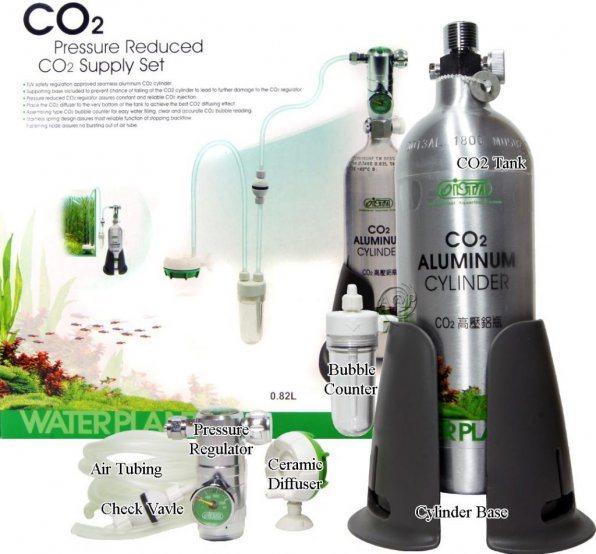

On sale you will find two series of ISTA Aluminum CO2 Cylinder cylinders, with horizontal and vertical threads 1 and 3 liters.
Fertilizers for aquarium plants... All fertilizers of any brand can be divided into MACRO FERTILIZERS and MICRO-FERTILIZERS.
Macro fertilizers - this is nitrate NO3 and phosphate PO4 from which plants take N-nitrogen and P-phosphorus. These are the most important elements after CO2 - C-carbon.
Remember - Redfield's proportion rules... Keep it under control at all times and everything will be ok. Right, based on our observations, the Redfield proportion rules only in full N-P-C ratios. Incomplete proportion - without carbon C does not give good results.
Micro fertilizers... These are all the other less important elements that are necessary for plants (see link). You should not place a strong emphasis on them. Firstly, they are all contained in one or another quantity in tap water and, with changes, are restored in the aquarium. Secondly, an overdose of micro very quickly leads to an outbreak of algae.
A common mistake for beginners is not understanding what they are pouring into the aquarium. For example, take such a popular and popular fertilizer as Tetra PlantaMin... Read the product annotation on the link - it strengthens, stimulates, gives a chic habit.
A beginner, without delving into the essence, applies it and gets an outbreak of algae, scribbles on the forums - "Like, fu, what a bad Tetra." And the trouble lies not in the drug, but in misunderstanding nitrogen cycle and balance in the herbalist... The beginner is skewing according to Redfield (let's say generally zero N and P) and instead of making up for the lack of these primary elements, he fills the aquarium with Tetra PlantMin - a micro-fertilizer (iron, potassium, manganese). As a result, busting on micro is only harmful, because plants lack a base - nitrogen and phosphorus.
Thus, you must understand what plants are missing and understand fertilizers.
How to understand what plants lack? It's simple. Now the market is packed with a variety of expensive and not very good aquarium water tests. We recommend from inexpensive domestic - drip tests VladOx, they are sold online and offline.


We also recommend, we will not be afraid of this word - innovative domestic tests UHE... They are currently only sold online.
The minimum set of tests for a herbalist is NO3 and PO4. It is desirable to have the entire nitrogen range: NH4, NO2, NO3. Also kH and pH tests.
Tests help us monitor the situation in the herbalist, but over time it is desirable to learn to see and feel the aquarium for ourselves. With experience, you need to move away from "seizure testing", the best aquarium test and instrument is ourselves.
Let's summarize this part. Macro, it is also macro in Africa. The link above generally contains a recipe for how to make them yourself. If you are not yet ready for samomes, then always and everywhere you will find a line of fertilizers from Tetra: Tetra Planta Macro, Tetra PlantaMicro, substrates, root tablets and more.


Of course, there are tons of other brands that make aquarium fertilizers. There is a possibility, use the products at least ADA. In taste and color, all markers are different. The main thing is to use it with a clear understanding of what you are using it for and what you want to get in the end.
From a professional line of fertilizers, at an adequate price, we can recommend Prodibo (soils, soils, macro, micro, stimulants, etc.).
So, something note turns into the Talmud. Not surprisingly, the topic is very broad. There is one moment left.
Water parameters for aquarium plants. Link1 and Link2, please look at these articles, they explain the essence well enough.
Here we note that the quality of photosynthesis is influenced by the process of caring for the aquarium: water parameters (kH, pH below 7), high-quality filtration and aeration, competent and timely water changes.
Please study
Soil for vallisneria
The substrate for the plant does not play a special role. But still, coarse sand or fine gravel will be the best option for planting it. The thickness of the planting layer also does not matter, since the roots of the culture are poorly developed and do not have a central core part.
However, so that the algae does not float to the surface, it is better to deepen it by 4-5 centimeters. The vallisneria root system branches out from the base of the algae, so a small area of the bottom of the aquarium will be enough for it to spread.
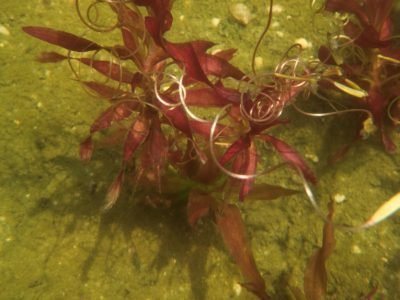

Planting rules
Experts recommend planting Vallisneria in small groups near the back and side walls of aquariums. It is best to place the plant near the filter, namely, where the water is drained, because then, thanks to the natural flow, the vallisneria leaves will be beautifully and evenly distributed over the entire surface of the aquarium.


Since the plant belongs to the category of floating plants, you can fix its position using decorative stones, shells, driftwood, large leaves of other underwater crops.
Vallisneria transplant
Transplanting is most often carried out in case of problems arising with the culture due to strong deepening or its initial planting in a shaded area of the aquarium. It can also come in handy when updating a bush with subsequent reproduction.
To transplant, you need to carefully dig the plant out of the ground, remove the damaged parts of the root system and dead leaves, and divide the bush if necessary.
Then the plant should be moved to the chosen place, spread the root system and sprinkle it with a layer of gravel, and to avoid floating up, press down the space around the bush with large pebbles, which should be removed after a week. It will take a plant up to several weeks to adapt and take root.
Alternantera is also an aquarium plant. It is grown when nursing at home without much hassle, if you follow the rules of agricultural technology. All the necessary recommendations can be found in this article.
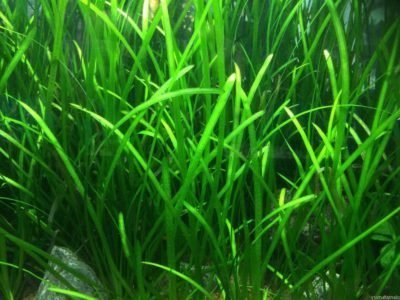

Vallisneria giant
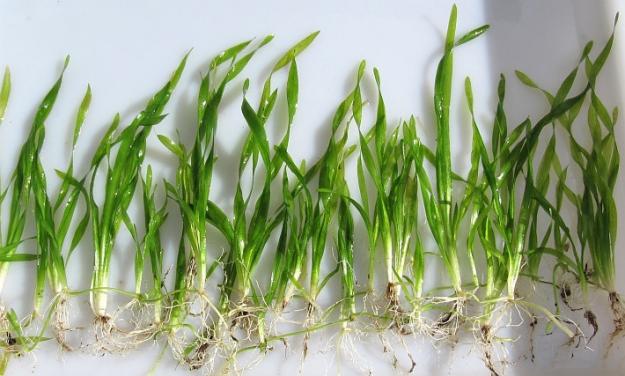

Reproduction of vallisneria photo can be increased
Vallisneria gigantic is a fairly large bushes with straight, rigid leaves of various shades of green, reaching up to 1 m in length.
It can only be grown in large aquariums. This representative of the vodokrassovy family is not picky about the conditions of detention, but due to its significant size it is rarely grown by aquarists. It grows, in the presence of artificial lighting, fairly evenly throughout the year. The homeland of this aquarium plant is Southeast Asia.
Giant Vallisneria can be grown in tropical or warm temperate aquariums. The optimum water temperature is 22-26 ° C, its drop below 20 ° C is not desirable. The plant is not demanding on water parameters, similar to other representatives of this species. But still, the best results are obtained by growing it in a soft, slightly acidic environment. As for the stiffness, it should be less than 8 °. Since this plant grows well in any, both old and fresh water, regular water changes are not needed, but it is still usually required due to other plants and fish.
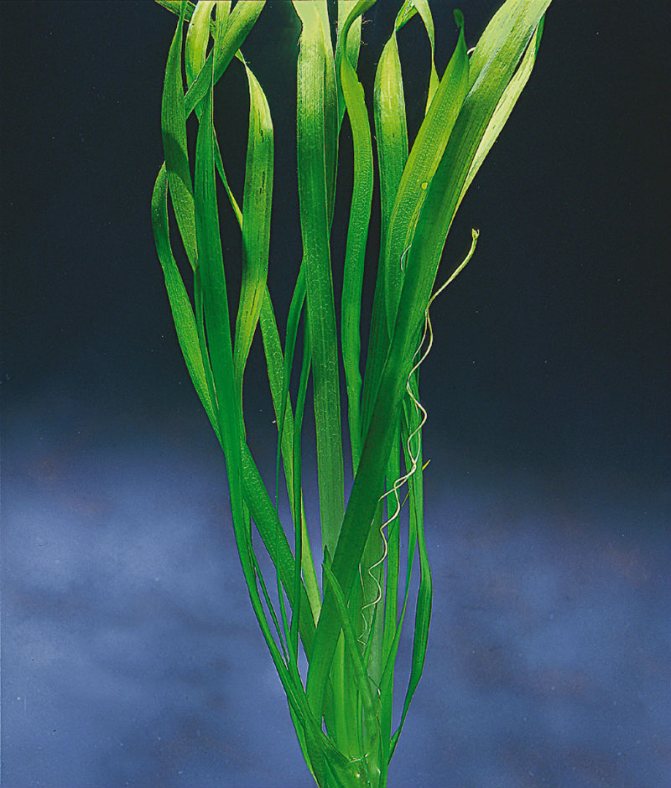

The peduncle of the photo can be enlarged
The lighting of the aquarium, when keeping this type of Vallisneria in it, should be bright enough. With a low aquarium, in addition to overhead lighting, it is desirable to have additional side lighting, since the leaves spreading over the surface shade the aquarium. The total duration of daylight hours must be at least 12 hours.
The substrate for the giant Vallisneria should be large and rich in nutrients. It grows well in old aquariums, where a lot of organic matter has accumulated at the bottom.Given the size of this plant, the soil should be large enough. You can use sand or pebbles with a grain of 3-4 mm. In order for the root system to develop well, a layer of soil is needed at least 8 cm. As noted above, the growth of this plant is badly affected by various salts dissolved in water. Reproduction in aquariums is carried out only vegetatively. As with other species of Vallisneria, young bushes are formed on the whiskers released by the uterine specimen.
Flowering vallisneria
In an aquarium, the plant blooms extremely rarely. In nature, flowering time occurs in mid-summer. The culture throws out an above-water peduncle with small white inflorescences for pollination by insects.
When the pollination process is completed, the peduncles go under the water and the process of formation of seed pods already begins there, which, after ripening, lead to self-seeding of the culture at the bottom of the reservoir.
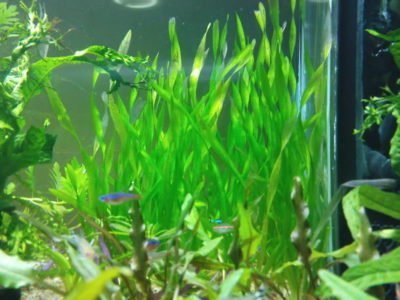

Beneficial features
Vallisneria forms amazingly beautiful cascades of leaf plates of a rich emerald green color. But, in addition to the decorative function, the plant also performs other important tasks.
Vallisneria perfectly filters the water in the aquarium, effectively cleaning it from impurities and harmful impurities, saturating the tank with actively released oxygen. This plant also creates shading and inhibits the growth of algae and weeds.
Vallisneria is a very beautiful and unusual aquarium plant that allows you to create an original design and performs a number of additional useful functions. This aquatic culture is especially loved by aquarists due to its unpretentiousness and lack of the need for careful, complex care.
But in order to ensure the full-fledged development of Vallisneria, to extend its eyelid, and also to protect it from a number of characteristic diseases, it needs to create optimal conditions of detention, assuming a sufficient amount of lighting, average hardness and acidity, and periodic replacement of water in the aquarium.
Vallisneria pruning
With a strong growth of the culture, it is not recommended to cut it off. Although some aquarists prune the leaves of the crop, this is wrong, as often such a procedure leads to yellowing and death of the algae.
To thin out the algae, the entire leaf rosette should be removed, replacing it with a younger one.


Features of the content
Vallisneria is an absolutely undemanding plant that is suitable even for novice aquarists. It is resistant to temperature extremes, but at very low temperature conditions, its growth processes are significantly slowed down. Vallisneria reacts negatively to very high indicators of water hardness, while its leaf plates become smaller and pale, and growth stops.
The plant itself performs a filtering function, and therefore can be in old water for a rather long time. But to ensure the health and attractive appearance of Vallisneria, it is recommended to periodically change the water in the aquarium, as well as purchase and install a special filter.
This culture may well do without fertilizing and mineral fertilizers. But for normal growth, full development, she needs a nutritious, soft, sufficiently silted soil. River sand or fine gravel is well suited for planting Vallisneria.
In insufficient light, the plant begins to stretch, and its leaf plates acquire an unhealthy yellow tint, fade and lose their beauty. To avoid such problems, aquarists are advised to use additional lighting in the form of LEDs and fluorescent lamps. Vallisneria reacts especially well to natural, sunlight.
This plant has the property of rapid growth and shading of the water surface.
In cases where the thickets of Vallisneria become too dense, create a lack of light for other crops and aquarium inhabitants, it is necessary to thin out the plant, removing it along with the rhizome.
Experts do not recommend trimming the tops of Vallisneria, since after such a procedure its leaves turn pale and begin to rot. In addition, the main cause of plant disease is the poor quality of tap water. For growing Vallisneria, it is recommended to use filtered, pre-purified water.
Reproduction of vallisneria
Aquarium Vallisneria is propagated vegetatively, since it does not give seeds at home. Thanks to the favorable microclimate created by the algae in the aquarium, it multiplies easily, forming many shoots. For a year, one plant can give up to two hundred young crops.
The shoots appear at the base of the Vallisneria and are fixed with their root system in the ground at a distance of 10 centimeters from the adult alga. You can separate and plant them only after three leaf plates and their own root system appear on them.


Reproduction methods
Vallisneria reproduces both by seed and vegetative means. In the first option, the presence of female and male subspecies in the aquarium is necessary, then pollination occurs, the maturation of achenes, which eventually begin to germinate.
However, most aquarists prefer the more convenient and comfortable vegetative breeding method for Vallisneria. For these purposes, plant shoots are used, which germinate upon contact with the ground.
After the sprout has rooted and several leaf blades have formed on it, it can already be carefully cut and transplanted. Under favorable climatic conditions and the correct content, Vallisneria multiplies and grows very quickly, throughout the whole year.
Diseases and pests
Like any other aquarium culture, Vallisneria can also get sick with various ailments. They often appear with improper care or with an excess or deficiency of any substances.
With the dying off and yellowing of the leaf plates, it is necessary to make up for the lack of iron... For this purpose, 0.1 ml / g of copper sulfate should be added to the water once a week. If this element is in excess, the leaf plates will also turn yellow, but the veins will retain their green tint. To eliminate supersaturation, it is necessary to use minimal amounts of manganese.
If the tips of the leaf plates turn yellow, the lack of calcium should be eliminated.... To do this, it will be enough to place a few shells at the bottom of the aquarium.
If the plant has little nitrogen, then in this case the edges of the leaf plates will begin to turn yellow.... To eliminate this problem, you should reduce the temperature in the aquarium, which will increase the concentration of the desired element in the water.
With a lack of phosphorus, the leaves of Vallisneria begin to turn red, and young plants darken and curl... To increase the concentration of this element in the water, you should add phosphorus fertilization to the aquarium.
If yellowish spots began to appear on the surface of the leaf plates, nitrophoska should be added in the amount of 2 grams per 100 liters.... It is necessary to repeat the procedure weekly until the amount of potassium is replenished and the signs of its lack disappear.
When blackening the tops of the leaf plates of a plant, it is necessary to eliminate the boron deficiencyby introducing 0.2 mg / l of the required substance into the water.
Lightening and dying off of foliage is evidence of a lack of copper.... To replenish it, you should use aquarium copper sulfate in a proportion of 0.2 milligrams per liter of water. After the algae is restored, its introduction should be stopped, since the excess of copper can kill the inhabitants of the aquarium and other vegetation, if any.
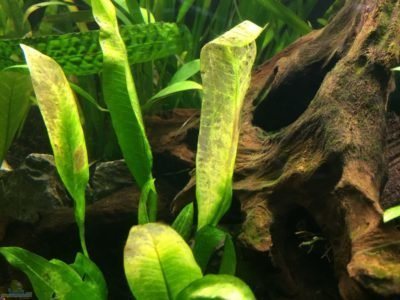

Neighborhood with other inhabitants of the aquarium
When planting vallisneria in an aquarium, you need to understand that it should not grow alone in it. Therefore, the growing conditions should be suitable for other inhabitants of the reservoir. Many aquarists are confident that this plant can get along with almost all other types of vegetation.
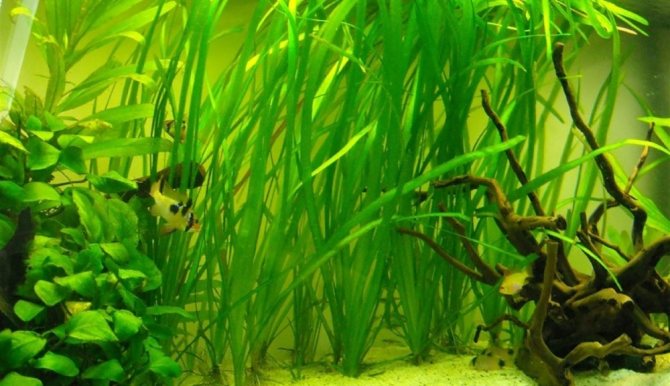

Vallisneria gigantea gets along well with other aquatic plants.
The "good" neighbors include:
- Hornwort.
- Water fern.
- Gigrophil.
- Water cabbage.
- Javanese moss.
There are also several unfavorable neighbors:
- Nymphea.
- Kabomba.
- Peristolis.
- Gerantera.
- Limnophila.
- Barclay.
Speaking of fish, almost every species can live normally in the vicinity of Vallisneria, without interfering with the plant. However, cichlids, despite the stiffness of the leaves, can begin to eat the foliage.
Botanical description
Vallisneria spiral is a very interesting plant. So, for example, his stem is visually invisible. The leaves are collected in a rosette, from the bottom of which a light brown thin creeping rhizome departs. With the help of short roots, the rhizome is fixed in the ground and daughter plants are formed on it. In an aquarium, reproduction occurs vegetatively.
The leaf blade has a lanceolate shape. The maximum length of the leaves is 80 cm, but in an aquarium they rarely grow more than 40 cm. The plate is soft, up to 8 mm wide, rolled into a free spiral. At the very base of the rosette, the shape of the leaves can change - they become straight, linear or heart-shaped. The edge of the leaf blade can be straight or serrate - with small teeth.
The color of the leaves depends on the level of lighting. If there is enough light, they turn dark green. With strong darkening, the leaves stretch out and turn yellow.
Vallisneria spiral is a dioecious (dioecious) plant. Female flowers resemble calla or calla lilies, as the long pistil is covered with perianths rolled into a tube. Each flower has a peduncle extending from the outlet to the surface of the water. It is very long and coiled.
Male flowers are almost invisible, tiny, collected in inflorescences, which are wrapped on top of the "veil" of the perianth. They have a short pedicel fixed in the axils of the rosette leaves. During the breeding season, male flowers are separated from the receptacle and rise to the surface.
Pollen from them falls on the pistil when the flowers float and touch each other. After that, the spiral of the peduncle twists and "drags" the pollinated flower to the bottom, where the formation and ripening of the fruit takes place. The seeds ripen in the box, with which the plant propagates.
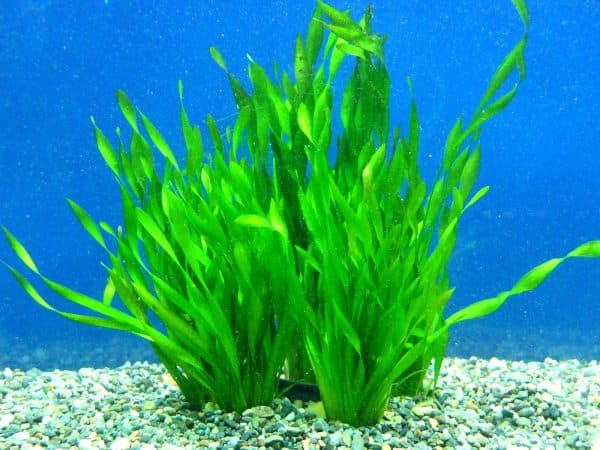

In addition, reproduction is possible and vegetatively - with the help of daughter plants that have grown from the buds on the rhizome. A young plant, in turn, gives out shoots and "babies". At the bottom of the reservoir, Vallisneria in a short time forms thickets, entangled with thin rhizomes.
Origin and habitat
Vallisneria is widespread in Iraq, China, Japan, Korea, India, Papua New Guinea, the Philippines, Australia, Canada, USA, Mexico, Guatemala, Honduras, Cuba, Dominican Republic, Haiti, and Venezuela. Long, flat, ribbon-like leaves growing from the base of the plant, serrated and rounded at the ends. The plant blooms all year round and is usually found in shallow water. The leaves grow up to 1.5 meters long and about 1 cm wide. A light green stripe runs along the center of the leaf.
Vallisneria gigantic grows in ponds, lakes, quiet streams at a depth of 1-4 meters. Vallisneria loves calm waters such as lakes or slow moving streams. It lives in fresh or brackish water of streams, lakes, rivers and bays. The giant Vallisneria got its name for the long ribbons of leaves growing from the bottom of the reservoir.
Flowering and pruning
Vallisneria is twisted-leaved.
In aquariums, Vallisneria do not bloom too often, but under favorable conditions and sufficiently warm water (not lower than + 25 ° C), the bush throws out threadlike peduncles, at the end of which there is a thickening. Rising above the water, the inflorescence is freed from the veil, and white petals open. After flowering, the stem twists in the form of a spring and tightens the inflorescence under the water.
When vallisneria grows too much on the surface and begins to shade the aquarium, you can prune it.At the same time, the largest bushes are removed from the reservoir, leaving daughter rosettes that have not yet reached the surface. It is impossible to cut off the leaf blades, since they die off. But 1-2 leaves (yellowed, old or damaged) can be removed from a low plant.
Distribution of the species
Vallisneria spiral (Vallisneria spiralis, Linnaeus, 1753) grows in Asia, Southern Europe and North Africa. This species is common in tropical and subtropical regions (Hussner & Lösch, 2005; Les et al., 2008; Hussner, 2012). The presented figure may give a distorted representation, because the results of observations are generalized to the borders of entire countries or continents (i.e., in central Africa, the species is recorded in one lake, which is located in two countries).
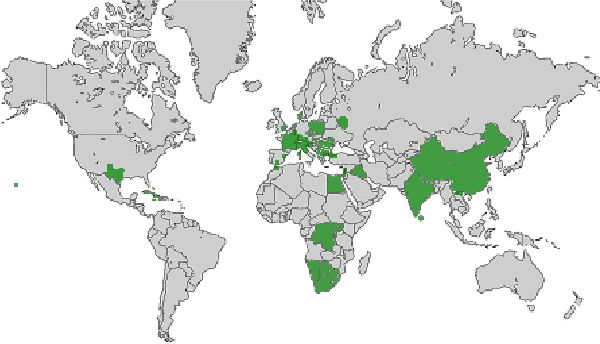

Distribution map of Vallisneria spiralis, Linnaeus, 1753
The countries where the species Vallisneria spiralis is represented are indicated in the table, although some areas of growth are controversial. According to Les et al (2008), due to the latest revision of the taxonomy of the species, the presence of Wallisneria in China and India is being questioned.
| Country | Origin | Link |
| Albania | introduced | Hussner (2012) |
| Austria | introduced | Les et al. (2008); Hussner (2012) |
| Belgium | introduced | Hussner (2012) |
| Botswana | unknown | Cook (2004) |
| Bulgaria | introduced | Hussner (2012) |
| Burundi | unknown | Copeland et al. (2012) |
| China | unknown | Li & Xie (2009) |
| Dem-i r-a Congo | aboriginal | Les et al. (2008) |
| Croatia | introduced | Hussner (2012) |
| Cuba | introduced | Lowden (1982) |
| Czech Republic | introduced | Hussner (2012) |
| Denmark with islands | introduced | Hussner (2012) |
| Egypt | aboriginal | Ali et al. (1999) |
| England | introduced | Hussner (2012) |
| France with islands | introduced | Lowden (1982); Dutrarte (1997); Hussner (2012) |
| Germany | introduced | Hussner & Lösch (2005); Les et al. (2008); Hussner (2012) |
| Greece | introduced | Hussner (2012) |
| Hungary | aboriginal | Lowden (1982); Hussner (2012) |
| Iraq | aboriginal | Lowden (1982) |
| India | aboriginal | Lowden (1982) |
| Italy | aboriginal | Lowden (1982) |
| Israel | aboriginal / introduced | Flora of Israel Online (2006) |
| Jamaica | introduced | Lowden (1982) |
| Luxembourg | introduced | Hussner (2012) |
| Macedonia | introduced | Hussner (2012) |
| Moldova | introduced | Hussner (2012) |
| Montenegro | introduced | Hussner (2012) |
| Morocco | unknown | Dijkstra (2012) |
| Namibia | unknown | Cook (2004) |
| Netherlands | introduced | Van Ooststroom & Reichelt (1961); Hussner (2012) |
| Nepal | unknown | Shrestha & Janauer (2001) |
| Poland | introduced | Hutorowicz & Hutorowicz (2008); Hussner (2012) |
| Romania | introduced | Hussner (2012) |
| Russia | introduced | Katsman & Kuchkina (2010) |
| Serbia | introduced | Hussner (2012) |
| South Africa | unknown | Cook (2004) |
| Spain with islands | introduced | Hussner (2012) |
| Sri Lanka | unknown | CABI (2012) |
| Switzerland | aboriginal / introduced | Schratt (1978); Hussner (2012) |
| Uganda | aboriginal | Les et al. (2008) |
| USA with Texas and Hawaii | introduced | Staples et al. (2003); Les et al. (2008) |
| Vietnam | unknown | Neve et al. (2009) |
Globally, the spread of Vallisneria is influenced by climate change. Warming water leads to the emergence of new settlements in the colder regions of Europe. The favorable environmental conditions allowed Vallisneria to become an invasive species (Hussner & Lösch, 2005; Willby, 2007).
Harmful effects of the introduction of a species on other plants In their work, Ejsmont-Karabin & Hutorowicz (2011) noted that Vallisneria spiralis completely replaces aboriginal underwater macrophytes in warm lakes in Poland. These lakes are heated by using their water to cool power plants in Poland. A similar effect was found by Bakbo et al (2010), who observed the replacement of all underwater plants with the exception of Nuphar. Vallisneria formed a dense single-species carpet at a depth of 2.5 meters (Bakbo et al., 2010). The planktonic algae content also decreased due to the growth of epiphytic algae on the leaves of Vallisneria spiralis (Socha & Hutorowicz, 2009). To date, there is no data on the possibility of transfer of parasites and infections by vallisneria.
Beneficial influence Despite the complete replacement of underwater plants by Vallisneria in the Polish Lakes, the population of rotifers and ciliated ciliates (Ciliophora) remained the same (Ejsmont-Karabin & Hutorowicz, 2011). Cilia became even more numerous with the arrival of Vallisneria than during Potamogeton or Najas (Bakbo et al., 2010). The high diversity of the protozoan community is not the result that researchers expected from the introduction of such a simple plant as Vallisneria spiralis. This is likely due to the dense canopy that creates complex horizontal and vertical structures (Ejsmont-Karabin & Hutorowicz, 2011). The variety of colocrata is also due to the formation of periphyton on the leaves of Vallisneria. It was released into the water column under the action of waves.On the other hand, the increase in the community of protozoa and rotifers could be due to the warming of lakes.
In Germany, the Erft River is also heated by cooling power plants and runoff from coal mines. Here Vallisneria spiralis competes with Sparganium emersum without displacing it (Hussner & Lösch, 2005).
Vallisneria maintains the transparency of the water in its natural environment. It releases allelochemicals that inhibit the growth of blue-green algae (Xian et al., 2006; Gao et al., 2011). Hence, there is a positive effect on the biodiversity of the entire system (Mukhopadhyay & Dewanji, 2004; Mukhopadhyay et al., 2007; Al-Asadi et al., 2007).
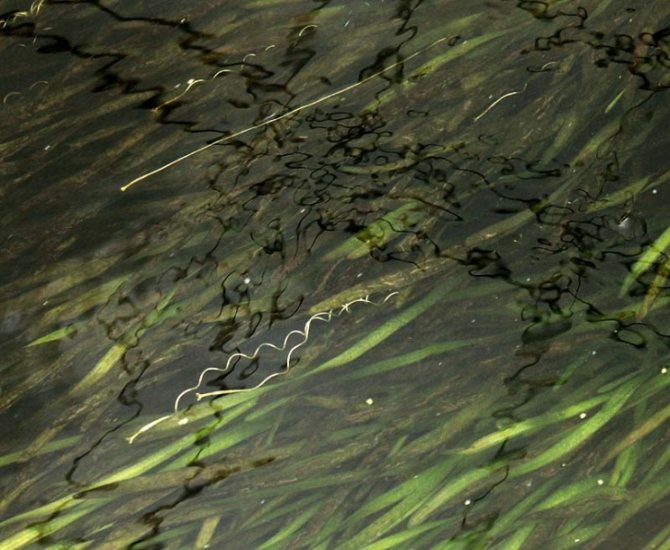

Vallisneria is spiral. Long spiral-curved pedicels are clearly visible. Moscow region. Lyubertsy district. The Pekhorka River near Korenevo. September 2011.
Maintenance and care
Vallisneria is an unpretentious aquarium plant. This is a great option for those who have just purchased an aquarium and are starting to get acquainted with the underwater flora. The bushes grow rapidly and let out lateral shoots, of which young shoots quickly reach the size of the mother bush. Therefore, the main task of the aquarist is to limit growth by pruning the leaves themselves and thinning new growths.
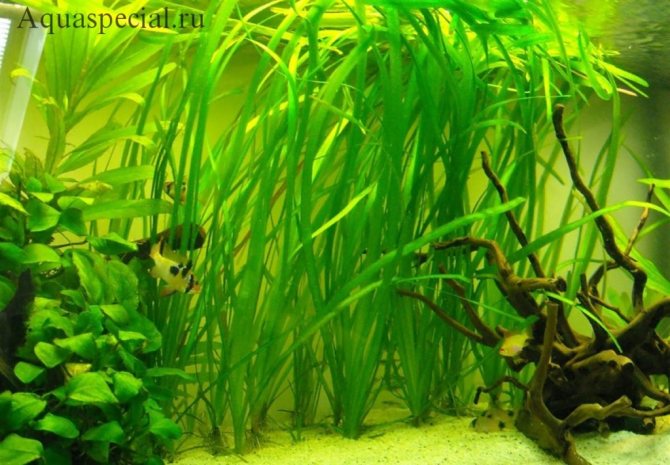

In general, there is no need to create special conditions for the cultivation of Vallisneria. As a rule, the following is enough for her:
Priming... A small layer of 3-4 cm is also suitable. The best option is sand or gravel with a fraction of 4-6 mm. The composition of the substrate itself does not matter, therefore, it is not necessary to apply fertilizers at the root. There is enough waste from the life of the inhabitants of the aquarium;
Make-up... Although vallisneria is unpretentious, it can begin to die if it lacks nutrients. Therefore, if the leaves have begun to rot, then you need to apply fertilizers in the form of a paste or tablets. Liquid macronutrients are also suitable;
Water parameters... The optimum temperature is 20-25 degrees, but fluctuations outside of these indicators are also permissible, but if the water is only 15 °, then the growth of the plant stops and soon it dies. In addition, the acidity should be 5-7 units, the hardness should be no more than 8 °;
Shine... Daylight hours should be about 12 hours, since vallisneria is still a tropical plant, and therefore it is used to a lot of light.
Vallisneria needs to be pruned regularly, but it is not necessary to shorten the sheets themselves, but to completely cut off the entire outlet, leaving only the young one. You also need to remember that there should be no iron in the water, otherwise the bushes will collapse very quickly.
We recommend visiting the section: Unpretentious aquarium plants
Why isn't Vallisneria growing?
It is difficult to unequivocally answer this question. In many ways, it all depends on the care of the aquarist himself and the conditions that he created. The reasons are different. For example, this:
- The temperature is too low;
- Short daylight hours or low light intensity;
- There are other plants near Vallisneria, the roots of which "press" on it (for example, this problem often arises if Cryptocoryne is located nearby);
- The water contains insufficient nutrients. In this case, you need to do a water test for nitrates and phosphates, and then see whether to apply fertilizers or adjust the frequency of changes;
- Undesirable chemical compounds or trace elements are present in the water. As already mentioned, Vallisneria cannot tolerate iron. She can also react negatively to algae medications.
Compatibility
Novice and experienced aquarists combine American and tiger species with algae and shady vegetation. They are planted in tanks containing mollusks, aggressive and peaceful phenotypes of fish, shrimp, and cryptocoryne.
But before disembarking, the optimal location is determined. So, these bushes and Cryptocoryne are concentrated near filtration equipment and aerators.After all, this vegetation needs clean water and constant oxygen supply.
Vallisneria is an amazing plant. With its help, conditions are created in an aquarium and other tanks that are necessary for the normal development and reproduction of phenotypes and mollusks. If you control its growth, then other algae, shady plants will develop normally.
Video about the aquarium plant vallisneria
AdminAuthor of the article
Did you like the article?
Tiger
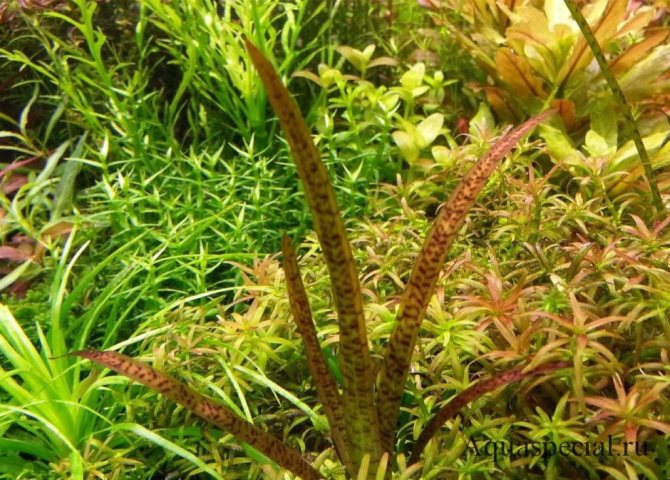

Has light green sheets. It is considered average in size, as it stretches up to 1 m. It has a variegated color, namely small dots and strokes of a darker shade. Because of this, the leaf slightly resembles a tiger's skin. This is where the name comes from;
Care and reproduction
In addition to the rules of maintenance, it is important to know how to care for a water flower. Caring for vallisneria does not require much effort and time, since the main condition is to cut and trim the regrown parts of the plant in time, especially if the leaves of the flower already cover the surface of the water surface of the aquarium. Cutting is carried out with sharp tools and with care, otherwise you can cause irreparable damage to the flower. In order for the plants to grow and develop well after planting, it is required to arrange the varieties of flora at a distance of 20 cm from each other.
If the required conditions for keeping are met, and male and female plants grow in the same aquarium, then soon inflorescences can be seen in an artificial reservoir. Pollination is carried out by a hydrophilic method, after which fruits and shoots appear soon. Reproduction is also possible vegetatively - for this it is necessary to cut off the young shoots of an adult plant, and plant the shoots in a pre-planned place. After rooting, the shoot releases its own leaves, and begins to grow and develop.
Vallisneria is an ornamental aquarium plant that is distinguished by its unpretentiousness and good looks. In addition, this type of flora has a positive effect on the aquatic environment of the reservoir, is a place of shelter for fry and spawning, and some plant species are also food for fish.
Reproduction
It is not difficult to get dense thickets of Vallisneria spiral in your aquarium, since it multiplies very quickly with the help of daughter root processes. Vallisneria is capable of producing up to several dozen daughter shoots annually. In addition, Vallisneria is capable of blooming, but flowering is not accompanied by the formation of seeds due to unisexual flowers. Under natural conditions, you can find both male and female inflorescences. Therefore, Vallisneria reproduces perfectly in the natural environment also with the help of seeds.
Economic use
Experimental studies were carried out at the Perm State Technical University, which confirmed the possibility of using higher aquatic plants in the process of biological treatment of urban wastewater to reduce the content of nitrogen and phosphorus salts in them. It was found that as a result of the use of Vallisneria spiralis L. plants in the tertiary sedimentation tank at a biomass density of 7 g / dm³, a contact time of 240 minutes and a waste flow rate of 6 m³ / day per 1 m³ of structures, the maximum removal efficiency from wastewater is: ammonium nitrogen - 66 %, nitrate nitrogen - 34%, nitrite nitrogen - 27.0%, phosphates - 41.0%.
Description
The peculiarity of the Vallisneria plant is the presence of a flexible root system with numerous processes. Whiskers and leaf sockets extend from the root system. The length of the rhizome reaches 8–10 cm.
The length of the leaves, which are part of the rosette, reaches 45-50 cm. They bend and form a layer of greenery. The leaves are green with a reddish tint. The leaf turns red only after ripening.Leaves include a certain percentage of calcium, metal, so they differ in hardness and density.
Vallisneria is covered with small flowers at certain times. After ripening, the flowers move upward, pollination occurs. Peduncle valisneria decreases after pollination, sinks to the bottom. Boxes with seeds also fall on the substrate.
Vallisneria is chosen by experienced aquarists for the aquarium. Some beginners study the description in order to grow plants in the future.


Recommended varieties
Vallisneria american biwaensis (Vallisneria americana var.biwaensis)... This variety has narrow, 3-5 mm wide, strap-like long leaves, 5-50 cm long, beautifully twisted. This variety is often referred to as spiral vallisneria. Vallisneria helix is very often used as a medium plant, or even a foreground plant in large aquariums. Vallisneria helix requires slightly more light than other varieties of Vallisneria, but it is also undemanding to water parameters and temperature.
Vallisneria American Mini Twister or twisted-leaved (Vallisneria americana "Mini Twister")... Often used for the foreground in an aquarium. As the name suggests, Vallisneria American Mini Twister is a fairly small plant. The leaves are short, about 10-15 cm long and more, the curled leaves are very attractive.
Vallisneria american natans or swimming (Vallisneria americana var.natans)... Her homeland is Australia, a very hardy plant suitable for an aquarium. Leaves are narrow, belt-shaped, with an average length of 50-100 cm with 3-5 longitudinal veins. The cross veins are randomly distributed throughout the leaf. Vallisneria Nathans is found in huge quantities in stagnant and running water. The plant is simple, undemanding, great for beginners, there are no special requirements for lighting, CO2, temperature of the content is 18-28 ° C, easily spreads with the help of shoots.
Description of the plant
Vallisneria gigantea is a very large aquatic plant with narrow green leaves that can grow up to a meter in length. They are very tough, so they are not eaten by the inhabitants of reservoirs and aquariums. These decorative bushes have a creeping rhizome, color - from dark green to bright salad, depending on the light and other growing conditions.
Vallisneria leaves are finely serrate on the sides, and smooth and rounded on top. It reproduces mainly in a vegetative way, since an adult plant produces many mustache-layering. They can be separated from the mother plant and transplanted when they have 4-5 of their leaves.
In nature, this dioecious plant blooms with small white phonographs floating on the surface of the water along with leaves, and propagates by seeds that are tied to female specimens. To obtain seeds with artificial breeding, it is necessary that heterosexual plants are kept in one reservoir or aquarium, and a lot of flowers have formed on them, and at the same time, which is difficult and impractical.
This tropical perennial loves soft and warm water, well-silted soil. Growing strongly, it forms a dense layer of green mass on the surface of the water, preventing the penetration of light and air into the reservoir or aquarium.
MAINTENANCE AND CARE
Vallisneria does not like the presence of certain minerals in the water. Treatment of fish with a solution of sodium chloride in a general aquarium, where such plantings are present, should not be carried out, as this disrupts its growth.
However, I have used salt in aquariums with this member of the Vodokrass family. At a low concentration of sodium chloride, characteristic of viviparous fish, there is no significant deterioration in the growth of such green spaces.
Vallisneria also does not like the presence of rust in the water.This problem occurs in cities where tap water is used to fill aquariums. Very often in Russia, it comes with rust, due to the use of iron pipes. Rust can also get into the water when using frame aquariums. This plant does not like copper in excess of water.
Sometimes salts of this metal are included in preparations against algae and snails. A similar situation may arise when treating fish. There is unverified information that Vallisneria dies when Bitsillin-5 is used to treat fish.
Propagated in home waters of this popular representative of the aquarium flora vegetatively. In good conditions, she independently releases a mustache, on which daughter bushes are formed. Young plants can be separated from the mother bush by cutting the mustache, after they have 3-4 leaves and root lobes. Reproduction by seeds at home is difficult and not advisable. This is also due to the fact that Vallisneria is dioecious and either male or female flowers are formed on each specimen.
Read also: Flowers for the letter g of the name of the photo garden
This representative of the family of vodokrasovnyh has no economic value. There have been attempts to use it, along with elodea, to treat wastewater in large cities. The wastewater is warm enough for Vallisneria to grow and reproduce in it all year round.
Even at the Perm University, research was carried out. When used in a tertiary sedimentation tank of treatment facilities, with a slow flow of water, the content of nitrogen and phosphorus salts in the water is more than halved
RICCIA DESCRIPTION, CONTENT, REPRODUCTION, PHOTOS, CARE.
Plant propagation
To propagate a popular representative of the aquarium flora at home in a vegetative way, you should create an optimal environment for it, close to natural. As a rule, a mustache grows in Vallisneria, which subsequently form daughter bushes.
It is possible to separate young shoots from the mother plant after the formation of several leaves and root lobes in the daughter shoots. By cutting the mustache, you can get a separate bush, ready for independent existence. It is quite difficult to grow vallisneria by seed at home. In addition, experts find it impractical, since the plant is dioecious. This means that each individual bush forms male and female flowers.
Food additives for fish
The presence of copper salts in water, which are sometimes used in the manufacture of preparations against algae and slugs, also does not benefit Vallisneria. And although manufacturers often deny the likelihood of a negative effect of drugs on aquarium vegetation, reviews suggest otherwise. In particular, after the addition of Bitsillin-5, a medicine for fish, to the water, Vallisneria spiral, giant perishes.
The value of vallisneria in an aquarium or artificial reservoir
Oxygen supply is the merit of the plant in the metabolic processes of the aquarium. Taking useful organic substances from the soil, it creates all the conditions for the full-fledged existence of living organisms in water, namely Vallisneria. Maintenance and care (plant species are numerous, but several of them are in predominant demand), carried out in accordance with the requirements of cultivation, will allow the bushes to multiply at an unprecedented rate.
In this regard, Vallisneria needs regular thinning of densely growing thickets. It is extremely important to remember that sometimes in shallow water bodies or aquariums of insufficient height, the leaves of the plant create an almost impenetrable green veil, which prevents natural light transmission. The solution to this problem is one - to reduce the bushes of growing Vallisneria.
Appearance: vallisneria is a beautiful bushes with narrow ribbon-like leaves 10 to 80 cm long.Vallisneria foliage is generally strong and resilient; different shades of green and red. Herbivorous aquarium dwellers are not dangerous, with the exception of burrowing species, which can pull out a weakly rooted plant. Some forms of vallisneria have very sharp leaves due to small teeth. Therefore, you need to handle it carefully so as not to cut your fingers. In nature, sometimes in a home reservoir, subject to abundant sunlight, Vallisneria blooms with beautiful small bells that adorn the water surface.
Spiral
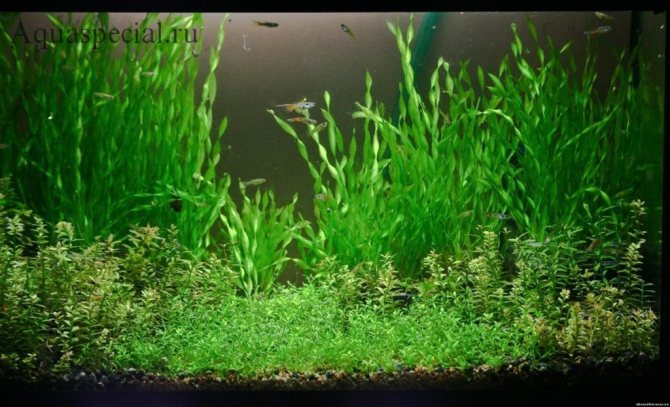

One of the most popular and beautiful species. Visually similar to Vallisneria vulgaris. But its peculiarity lies in the fact that all the leaves are twisted into a spiral, which makes the bush look especially attractive. This is the first human-discovered Vallisneria. Twisting is typical for female bushes. In nature, the plant reaches 80 cm in length, the width of the leaf is no more than 1.2 cm. Reproduction takes place vegetatively or through seeds. Flowers ripen, float, and then pollination occurs through direct contact;


